Italian basil pesto lasagne al forno (also called lasagne alla Portofino) is hands down the best summer lasagna recipe. It’s light, easily made vegetarian and just totally delicious. If you love pesto, you’ll swoon over this dish!
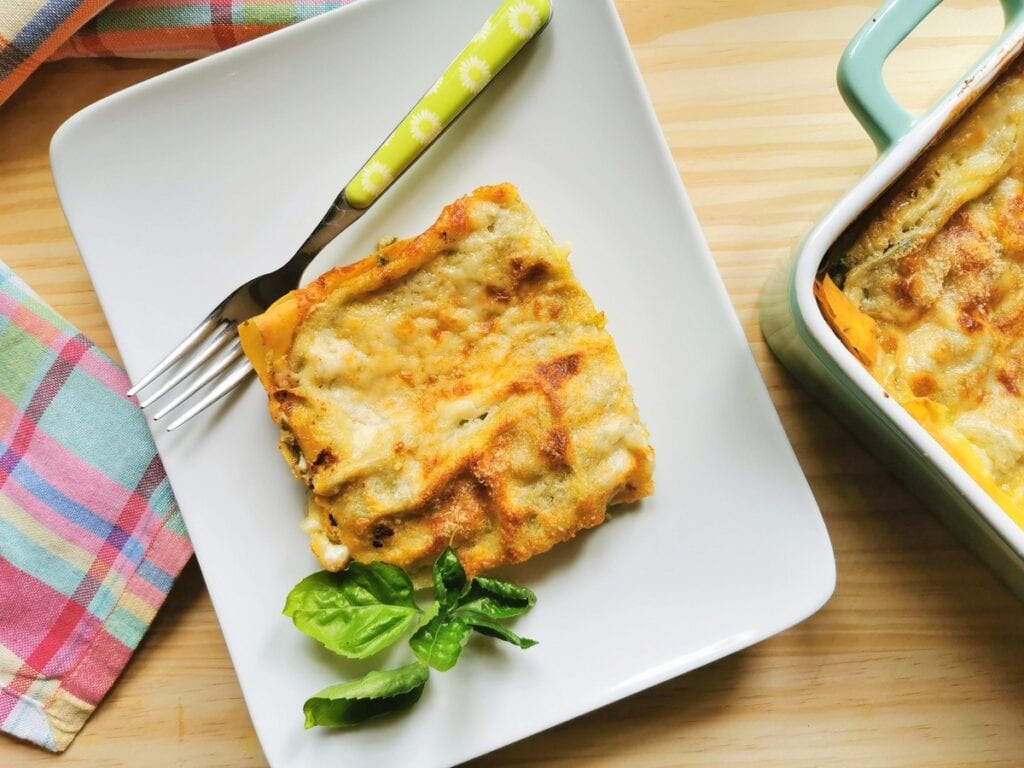
History
This divine pesto lasagna recipe comes from Liguria, home to pesto Genovese (basil pesto). Although many Italians call this dish lasagne al pesto, traditionalists don’t. For the Genovese, the original lasagne al pesto isn’t baked and the pasta is cut into squares, rather than rectangles.
In the local dialect, those pasta squares are called ‘mandilli de saea’ or silk handkerchiefs. Silk handkerchief pasta with basil pesto is considered to be the oldest pasta pesto pairing.
In Italy, you can also find this pesto lasagna referred to as lasagne alla Portofino (Portofino style lasagna). However, I couldn’t find any online info on how it came to be called that. Maybe, just not to be confused with the original lasagne al pesto or because Portofino is such a well-known Ligurian destination.
Plus, to make things even more confusing. There are other pasta alla Portofino recipes. These include mixing pesto with tomatoes, which apparently horrifies the Genovese!
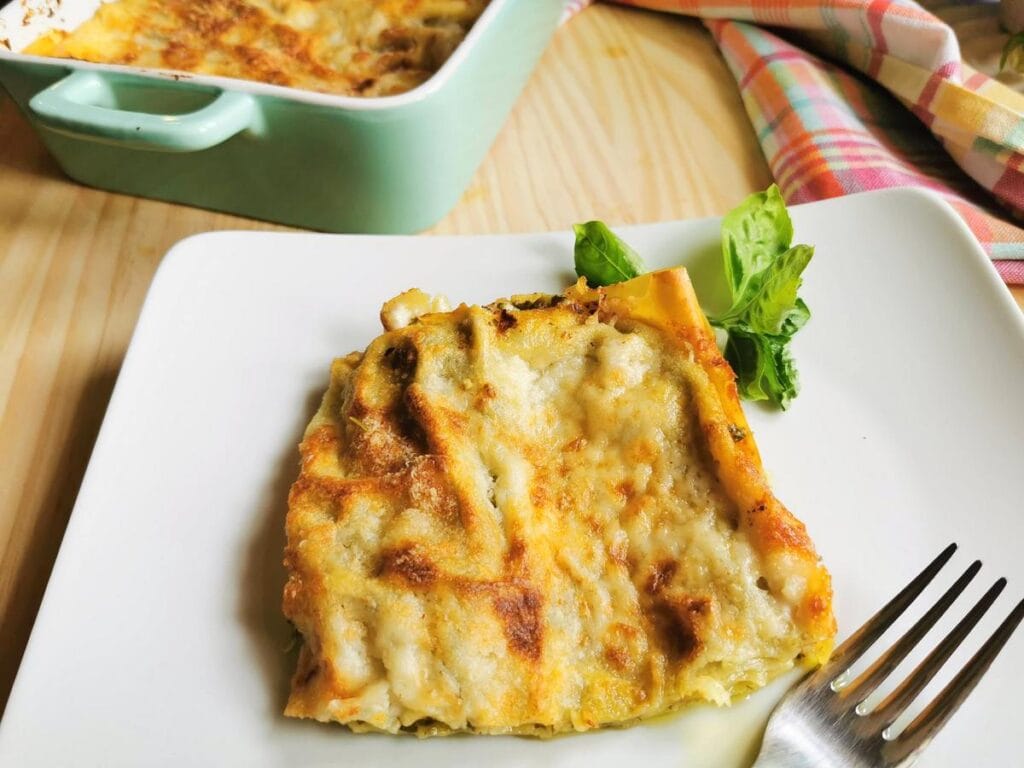
Even though this recipe is relatively modern in comparison to other pasta and pesto recipes, it has become pretty popular both in Liguria and throughout Italy. Genova was the first place in Italy to master the art of making fresh pasta. In fact, they’ve been making it there since the 12th century! However, basil pesto was a later addition to the Ligurian kitchen, having been invented in the 1800s.
Before they invented pesto, the Genovese ate their lasagne pasta either cooked in broth and sprinkled with cheese or seasoned with condiments such as prescinsêua cheese (a cross between yogurt and ricotta), normal ricotta and cinnamon or sauces of mushrooms and hazelnuts.
The official basil pesto ingredients.
Basil pesto (pesto Genovese) originated in Liguria. There, they have an official recipe for it published by the Genova Chamber of Commerce. This official recipe has seven ingredients: Ligurian basil leaves, Vessalico garlic, Mediterranean pine-nuts, Ligurian extra virgin olive oil, coarse sea salt and both aged Parmigiano and Pecorino from Sardinia.
Of course, those exact ingredients are hard to find even here in Veneto. So, most of us have to use locally sourced basil leaves, pine nuts, garlic and extra virgin olive oil. Both cheeses are also not easy to source. In fact, I often make basil pesto with just Parmigiano.
Ingredients
Basil Pesto:
- Basil: For the best flavor and aroma, use fresh, medium-sized, bright green basil leaves.
- Garlic: Use fresh garlic instead of ready-made minced garlic, as the minced garlic contains preservatives that affect the flavor.
- Parmigiano Reggiano: Adds a savory depth to the pesto. If you need a vegetarian option, look for a vegetarian parmesan, as Italian parmigiano contain animal rennet
- Pecorino: Offers a sharp, salty bite. You can use pecorino Romano or Pecorino Sardo. If both unavailable, you can increase the amount of Parmigiano Reggiano instead.
- Pine Nuts: These nuts add a rich texture and subtle nutty flavor to the pesto.
- Olive Oil: High-quality Italian extra virgin olive oil is recommended for the most authentic flavor.
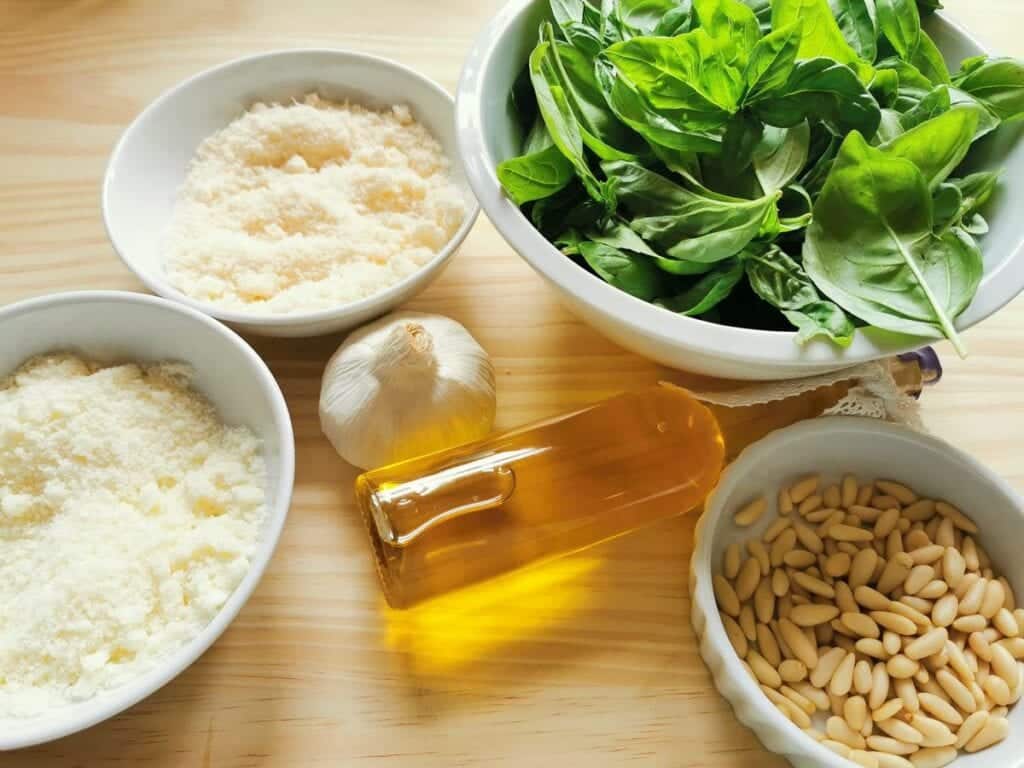
Béchamel Sauce:
- Butter: Starts the roux for the béchamel. Ideally use unsalted butter to better control the seasoning of your sauce.
- Flour: You can use all-purpose flavor, also known as plain flour, or you can also use '00' flour.
- Milk: For the creamiest and richest béchamel sauce, use fresh whole milk.
- Nutmeg: Freshly grated nutmeg adds a subtle warmth and spice to your béchamel sauce, giving it more flavor.
Lasagna:
- Lasagne Sheets: You can use dried, store-bought fresh, or homemade pasta sheets. If using normal dried lasagne or slightly thick fresh sheets, par-cook them in boiling water until they are almost al dente before assembling. For no-boil dried lasagne or very thin fresh sheets, you can layer them directly into the dish as they will cook through during baking.
- Provolone Cheese: Is used for its excellent melting qualities; slice it thinly for even layers. You can substitute provolone with mozzarella if it's unavailable. Both these cheeses are available in vegetarian versions although in Italy they are traditionally made with animal rennet.
- Parmigiano Reggiano: Sprinkle generously on the top layer for a golden, crispy finish when baked. Use a vegetarian parmesan if you follow a vegetarian diet.
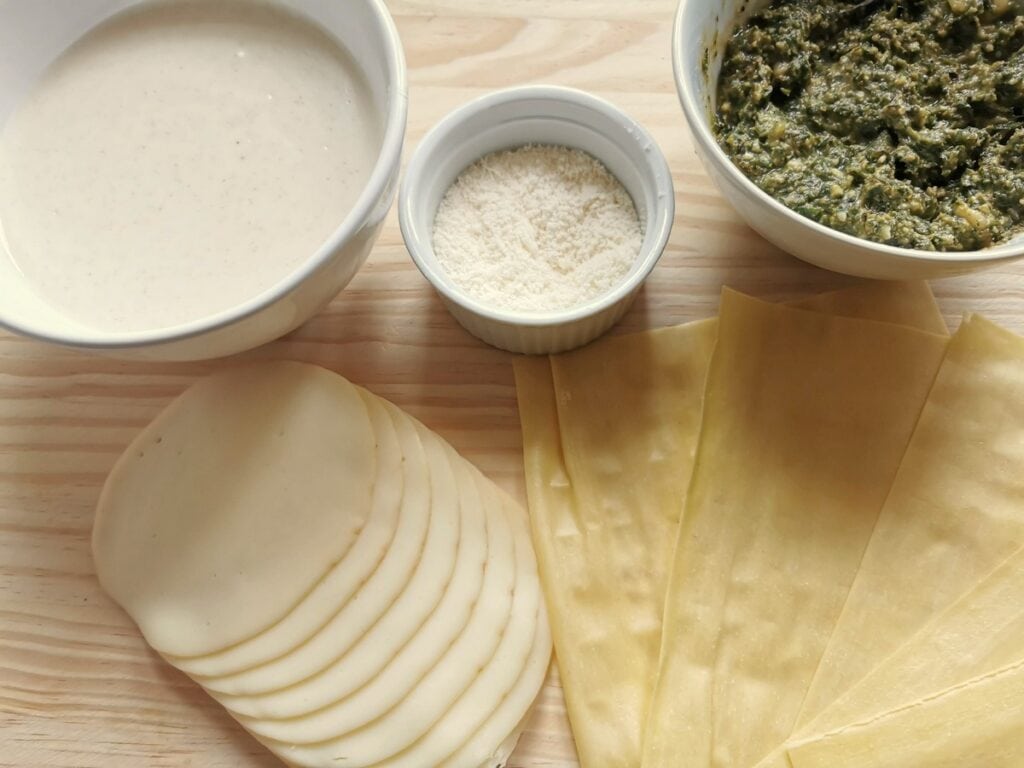
Versions of Italian basil pesto lasagne al forno.
Like many traditional Italian recipes, you can find this pesto lasagna made in slightly different ways. However, the most common is this recipe with homemade basil pesto, fresh lasagne pasta sheets, homemade béchamel and grated Parmigiano cheese. I also added some slices of provola cheese as some recipes call for that too and I liked the idea.
Some Italians add ricotta, mozzarella or mascarpone to this dish. Others include veggies such as zucchini or tomatoes or with green beans and potatoes, traditional ingredients in pesto pasta recipes.
There are also versions with meat such as ham or with seafood like shrimps. I preferred to go with the simplest and most basic recipe. However, I made both the pesto and the béchamel myself.
Step by Step Instructions
This pesto lasagna recipe includes three parts: making the basil pesto, making the bechamel sauce, and layering and cooking the lasagna. If you have store-bought basil pesto or bechamel sauce, you can skip those steps.
Making the basil pesto
1) If possible, choose medium-sized young leaves (brighter green). Rinse the leaves under water and dry them well with paper towels.
2) Mash the garlic cloves in the mortar using the pestle. Then add pine nuts and grind them with the garlic to make a paste.
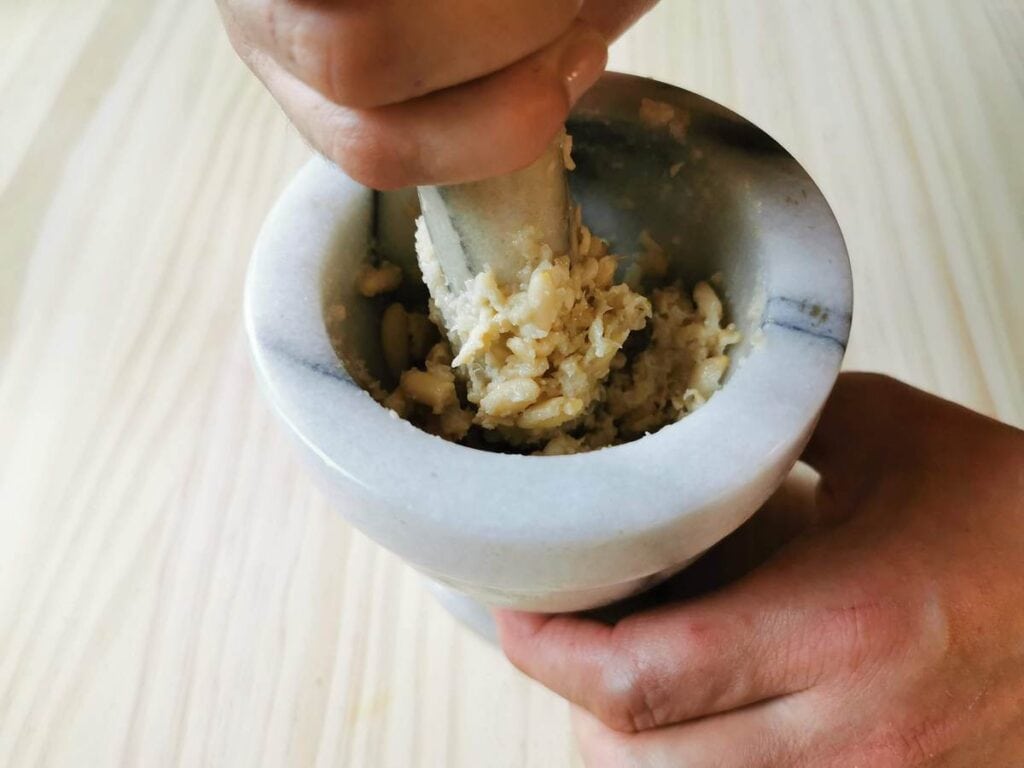
3) Add basil leaves (a few at a time) and a little olive oil and grind together with the garlic and pine nuts.
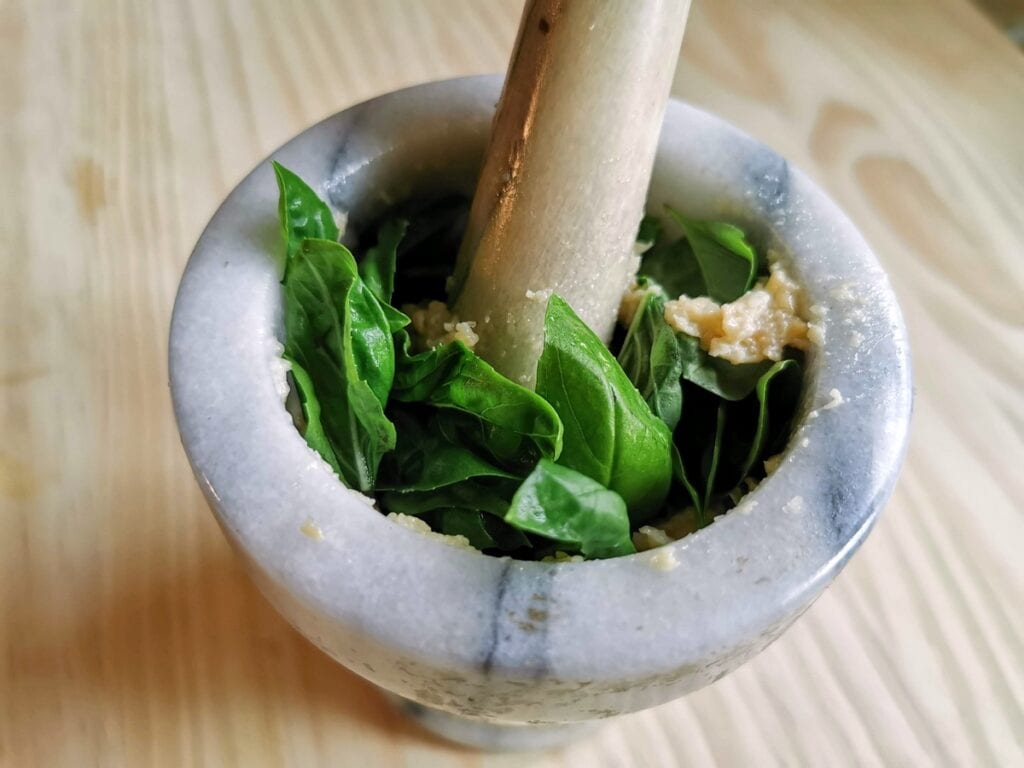
4) Once you have added all the basil, mix in the cheese and adjust the consistency with extra virgin olive oil if needed.
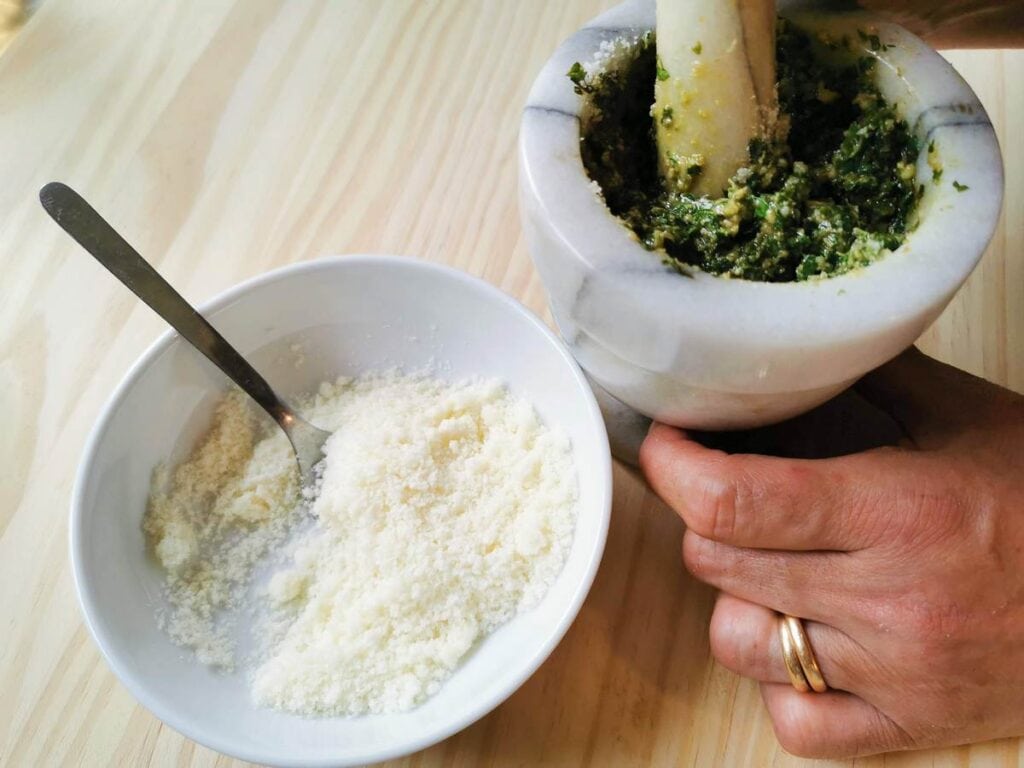
Making the bechamel sauce
1) Melt butter in a pan over low heat, stir in flour to form a thick paste (roux), then remove from heat.
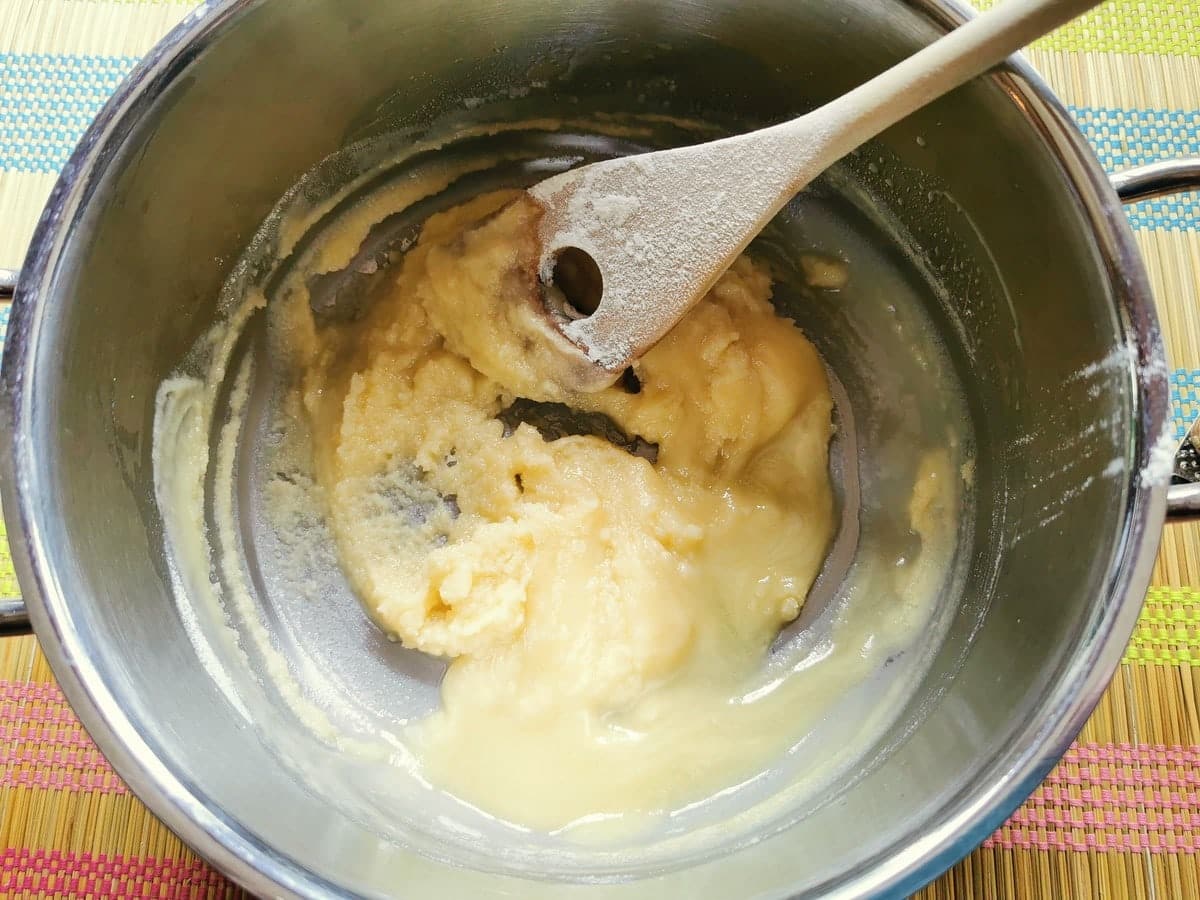
2) Slowly add the milk and stir continuously to dissolve the roux without making lumps. Put the pan on moderate to low heat and keep stirring constantly until it starts to simmer and thicken. Lower the flame, wait a couple of minutes, then turn it off.
3) Add a pinch of salt and the nutmeg, mix it again for a few minutes and then allow it to cool to thicken it further. You can also leave it in the fridge.
Note: If the béchamel seems too thick when you are ready to assemble your lasagna, you can mix in some more milk.
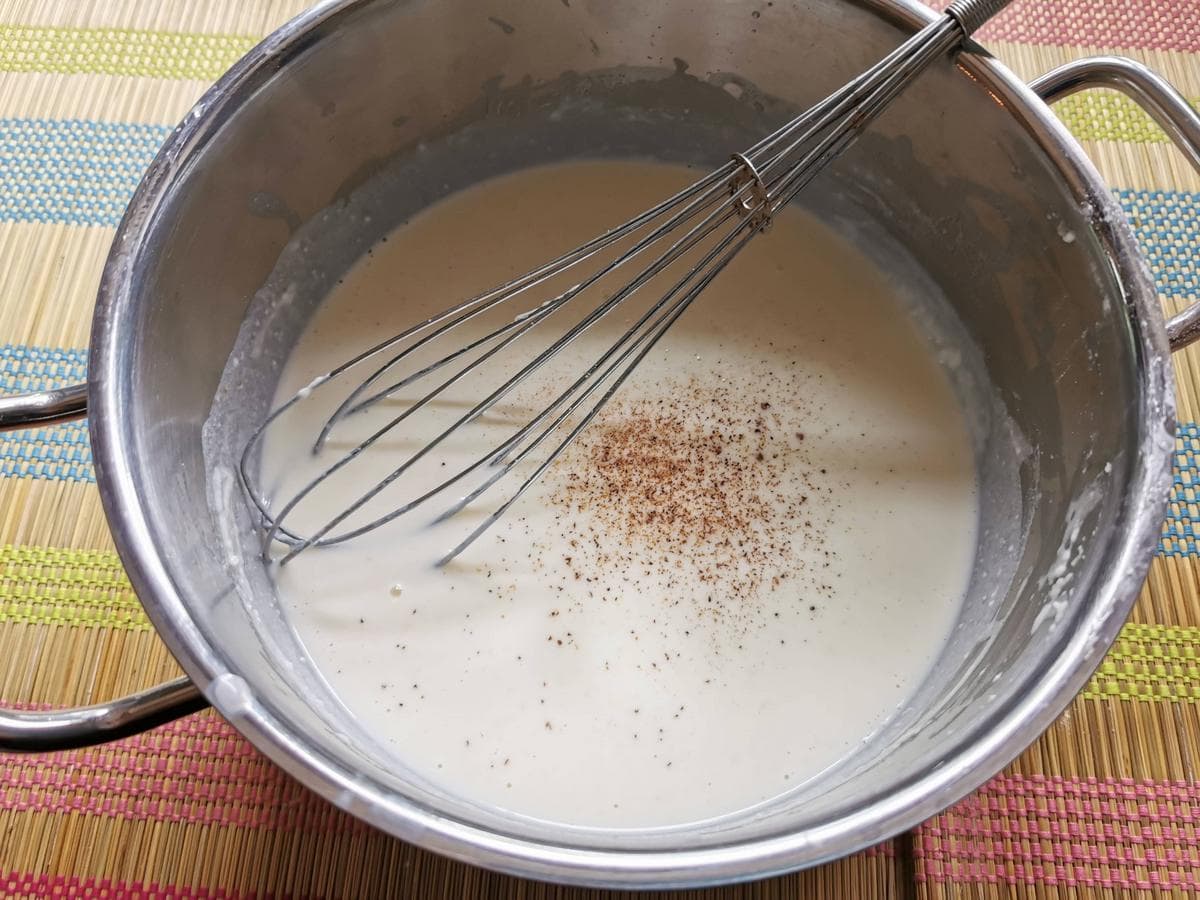
Layering and Cooking the Pesto Lasagna
1) Preheat your oven to 350°F (180°C).
2) Fill a large pot with water and bring it to a boil. Once boiling, add a generous amount of salt and a splash of olive oil, then bring to a boil again and add the lasagna sheets. Once halved cooked, drain the lasagna sheets and set to the side.
Note: If you're using fresh pasta sheets, they won't need pre-cooking unless they are quite thick.
3) Start to assemble your basil pesto lasagna. Spread some béchamel on the bottom of an oven dish. Cover with pasta sheets and spread more béchamel over the pasta.
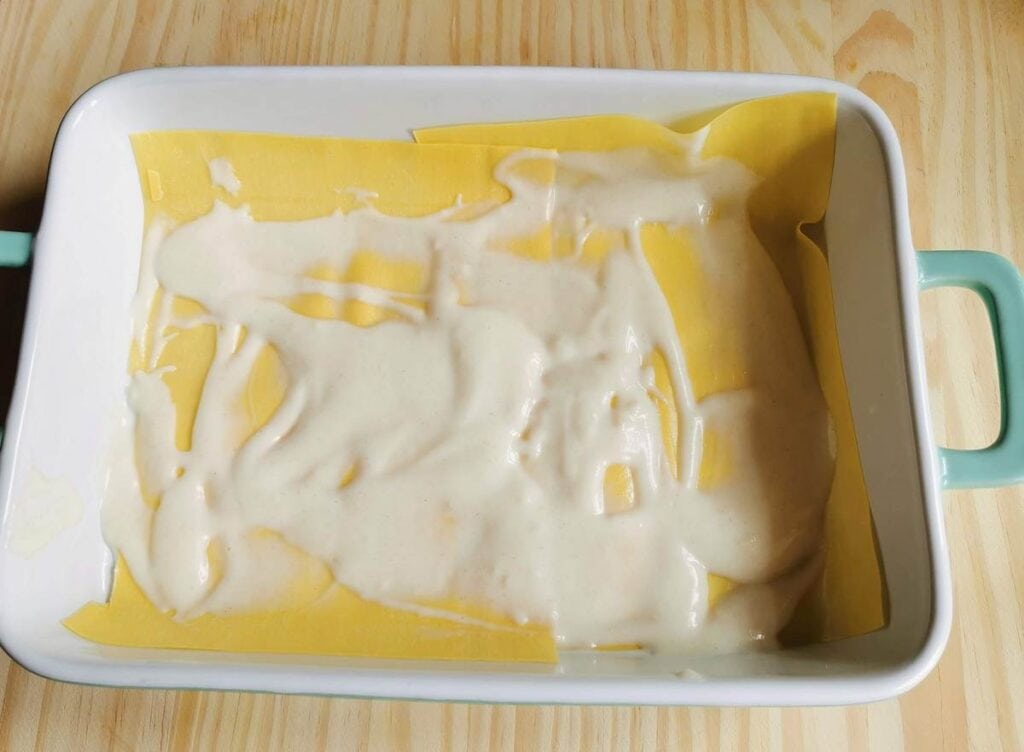
4) Add some pesto and mix it with the béchamel sauce.
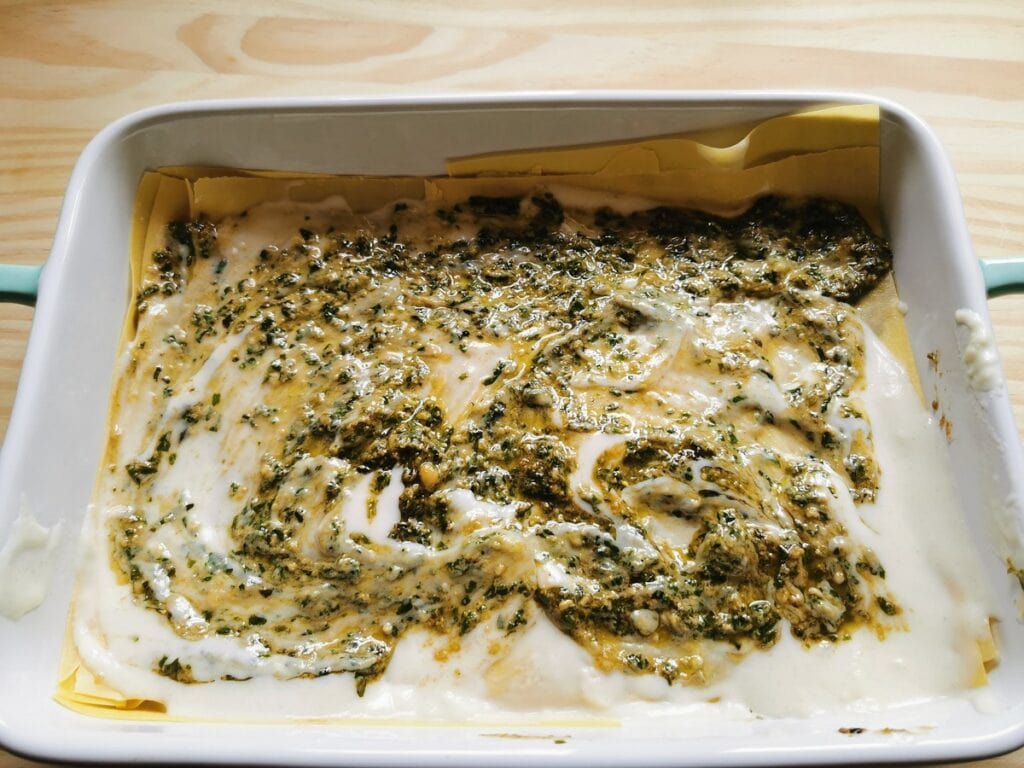
5) Place slices of provola cheese onto the béchamel and pesto. Continue with other layers; pasta, béchamel, pesto, cheese until you have used all the lasagna sheets.
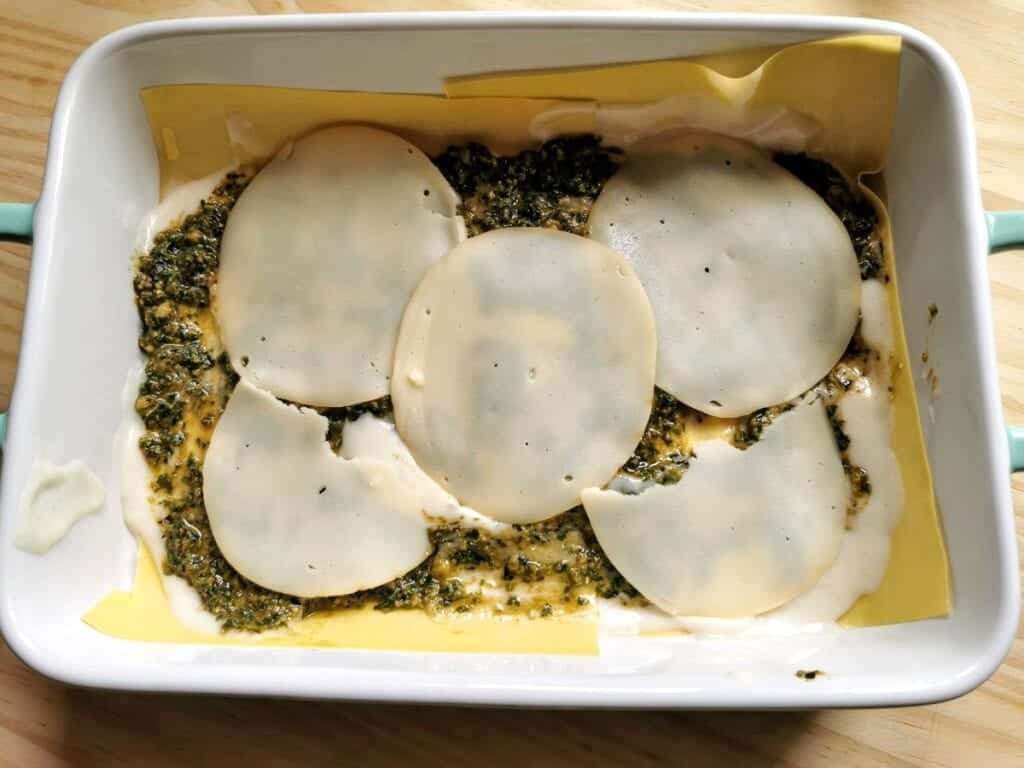
6) Finish with a layer of béchamel sauce and a generous sprinkling of grated Parmigiano Reggiano on the top.
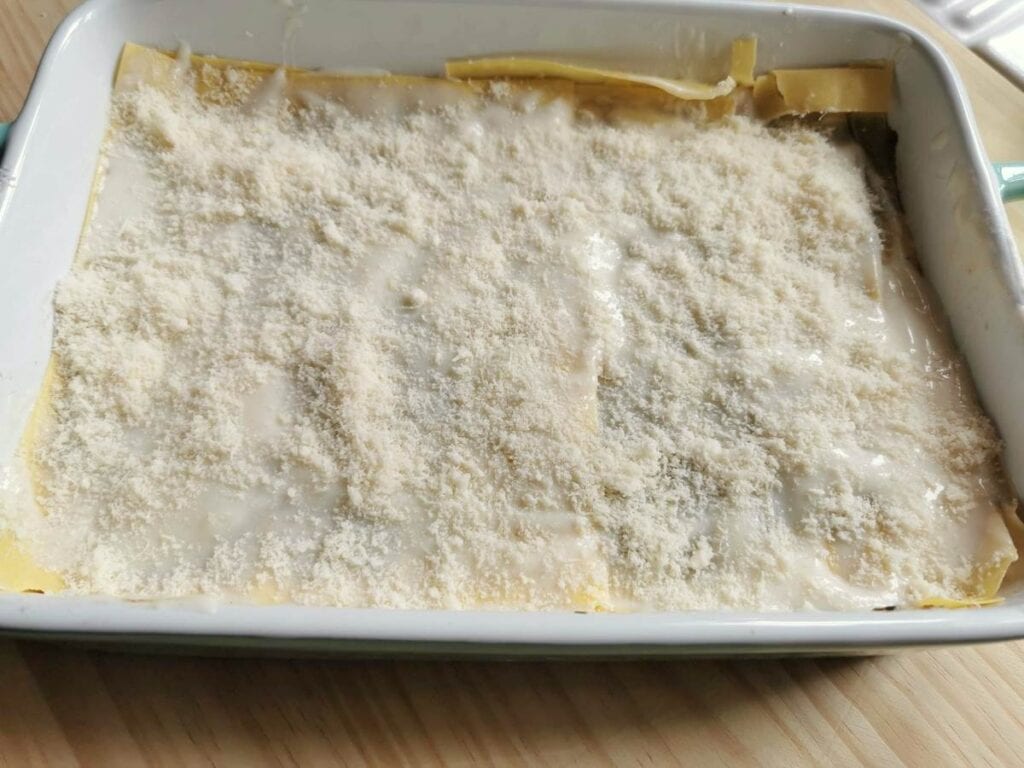
7) Bake in the oven for about 30 minutes. Check the pasta is cooked by piercing with a sharp knife. Cover and set aside and let the lasagna rest for 5-10 minutes before serving.
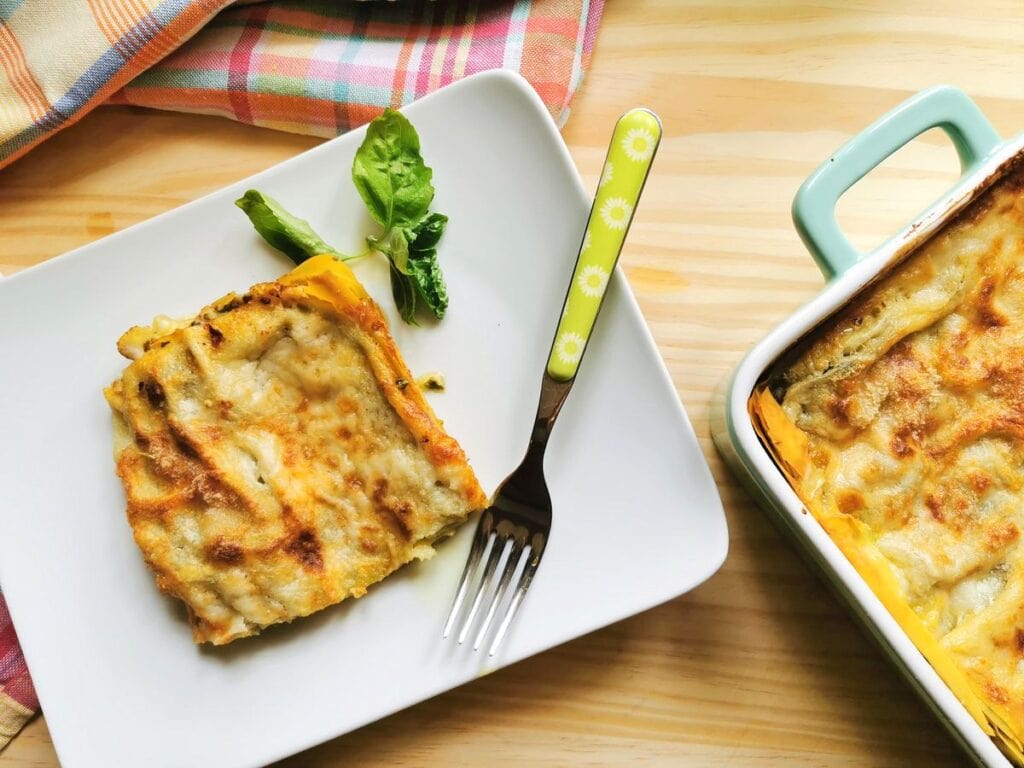
Storage and Leftovers
Storing Leftovers: If you have leftover pesto lasagna, allow it to cool to room temperature before covering it. Store in an airtight container or tightly wrap the dish in plastic wrap or aluminum foil. It can be refrigerated for up to 3 days.
Reheating: To reheat the lasagna, place it in an oven preheated to 350°F (175°C). Cover the lasagna with aluminum foil to prevent the top from burning or drying out. Heat for about 15-20 minutes, or until thoroughly warmed through. If you're reheating a smaller portion, a microwave can also be used. Heat on medium power in a microwave-safe dish, covered, for 2-3 minutes or until hot throughout.
FAQs
Traditionally, in Liguria, basil pesto is made using a pestle and mortar. This method allows the ingredients to have a more rustic texture. I used this traditional approach for the pesto in this recipe. However, if you're pressed for time, you can also use a food processor. I often do!
Absolutely! You can use store-bought basil pesto and béchamel sauce to speed up the preparation process. Simply layer these with your pasta sheets and cheese, and your lasagna will be ready to bake in no time. While it's convenient and still tasty, using homemade pesto and béchamel will offer the best flavor. If time allows, consider making these components from scratch for a really authentic Italian experience.
The traditional cheeses used in this recipe, Parmigiano Reggiano and Pecorino, are not vegetarian as they include animal rennet. For a vegetarian-friendly version, use cheeses that are labeled as vegetarian, which are free from animal rennet
More Recipes You May Like:
- Malloreddus with pesto and tuna
- Minestrone with basil pesto
- Corzetti with pesto, green beans and potatoes
- Sicilian pesto
- Trofie pasta with rocket pesto
- Asparagus Lasagna
In my opinion, this Italian basil pesto lasagne al forno was one of the best meatless lasagna recipes I have ever tried. My Italian hubby Salvatore thought so too! I’m sure if you make this recipe, you’ll love it as much as we do! And if you do, please let me know what you think! Write a comment here on the blog or post a comment on the Pasta Project Facebook page.
Your feedback means a lot to me!
Buon appetite!
Pin for Later:
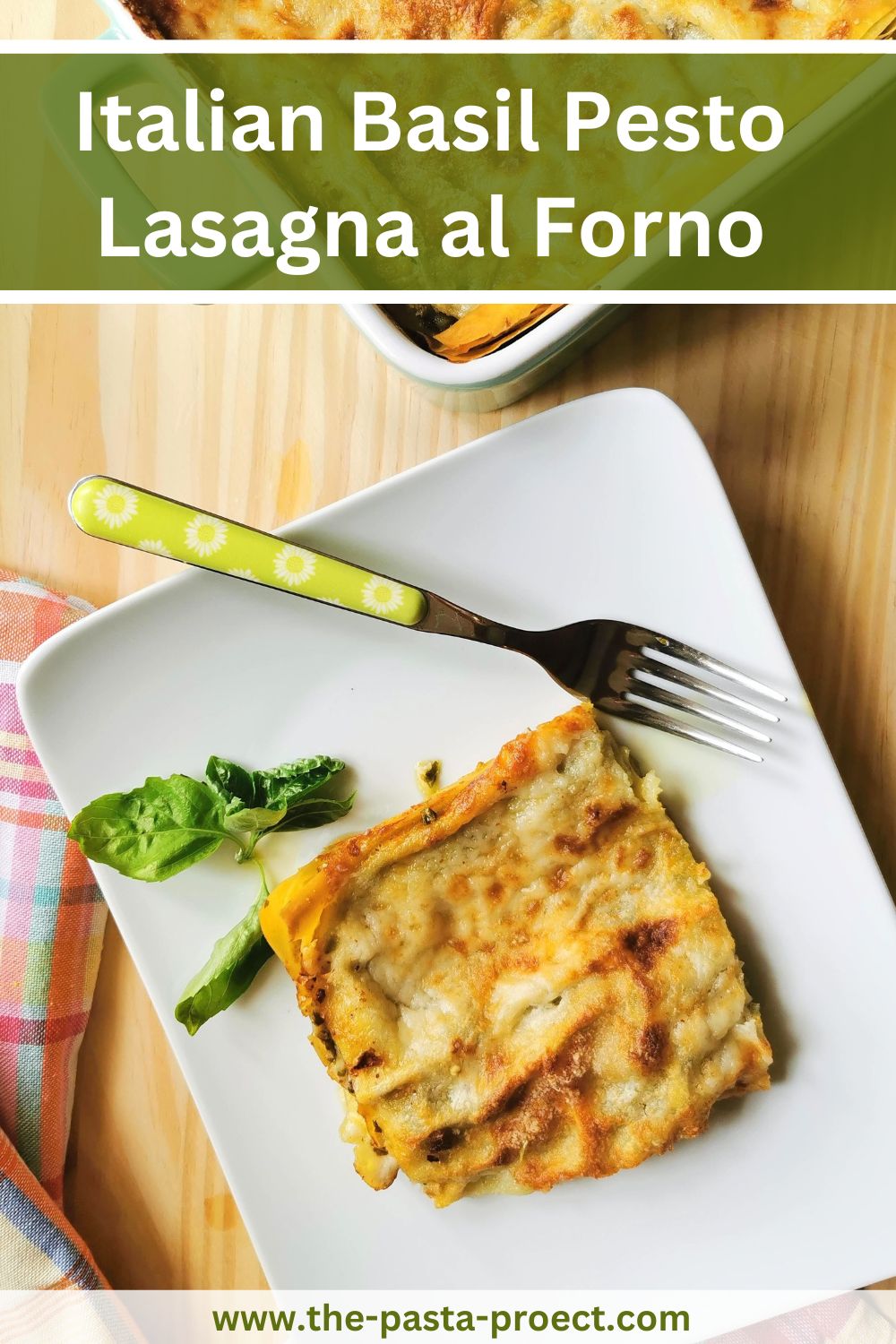
If you are interested in learning how to make homemade pasta and different types of gnocchi, check out my shop page for some great video online courses from my friends in Rome! Nothing beats learning to make pasta from Italians! Plus while you’re there why not order a copy of my pasta recipes cookbook!?
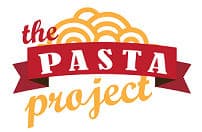

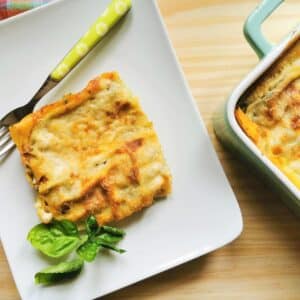
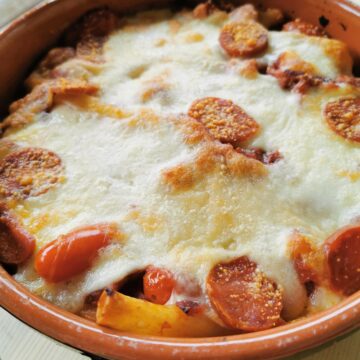
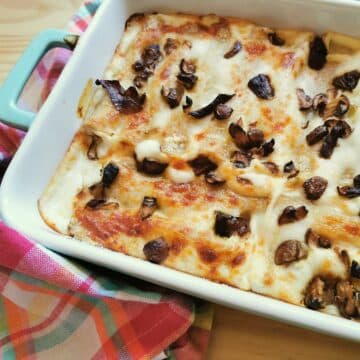
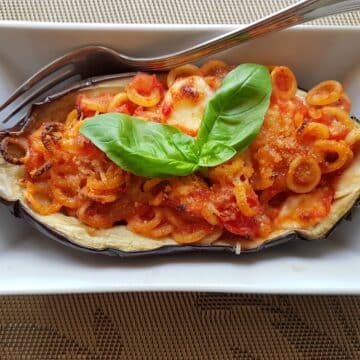
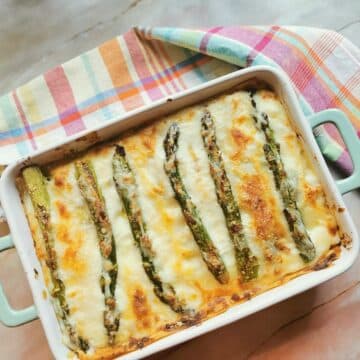
michele says
This is the 35th recipe I have made from the Pasta Project, and every one of them has been superb except for the one I goofed and didn't use really tasty mushrooms! Thank you, big thank you, as always Jacqui.
This was an easy meal for family in mid summer when it is hot and humid. I 'cheated' and used the last of my frozen pesto from last year, and no-boil pasta sheets. It would be so much better with fresh pasta, and likely also fresh pesto, but my pasta provider, my daughter, is distracted by a toddler, and my basil isn't yet plentiful enough to make the pesto. I found this a quite rich dish, so for me smaller portions suffice. It reheats well. Somehow the remainder disappeared from my fridge at lunch time while I was out today. Hungry family in residence!
Jay says
Hi Jacqui,
Since my basil is not ready for harvest but my arugula is. is this dish ever made with arugula instead of basil?
Thanks
- jay
Jacqui says
Hi Jay, I have never made this lasagna with arugula but I see no reason why it wouldn't work. If you try it. Please let me know how it turns out.
Karen D. says
Hi Jacqui,
I'm hoping to make this for Christmas dinner, and have a question. If I'm using homemade pesto that I already have on hand, how much should I use?
Thanks so much in advance!
-Karen D
Jacqui says
Hi Karen, thanks for your comment. The amount of pesto you use depends slightly on how many layers of pasta you end up with but usually for 4-6 servings around 150-200g (5-7oz). Do let me know how your lasagna turns out. Merry Christmas!
Karen Johnston says
Hi Jacqui, This recipe sounds delicious! Can I prepare it a head of time and then bake later in the day? or maybe it would be better to bake and then re-heat?
Jacqui says
Hi Karen, thanks for your comment. Yes this pesto lasagna is really delicious. I don't usually prepare my lasagna much ahead of baking but reheated leftovers are really good, so if I needed to make this in advance, I'd bake and reheat. Having said that, many Italians do prepare ahead of time and bake later the same day. In that case, seal the dish well with plastic wrap and keep it in the fridge. Then bring it back to room temperature before baking.
John says
At what temperature do you bake the lasagna? Did not see it mentioned in the recipe or accompanying article. Thanks!
Jacqui says
Hi John, thanks for youe comment. I obviously made a mistake by not putting the baking temperature in the recipe instructions. I'll update it tomorrow but in the meantime it's 180°c (356 °f).
Jere Cassidy says
I love pesto but have never thought of putting it into lasagne. I feel I have missed out. Again, glad to have your pasta recipes and to learn all the history.
Amy Nash says
I loved reading a little about the history of this dish! And that bit of nutmeg in the bechamel makes such a huge difference, especially when it's freshly grated.
Moop Brown says
I'm a big fan of pasta dishes with pesto and love how easy to understand this recipe is. Seems like a great meal for weeknights